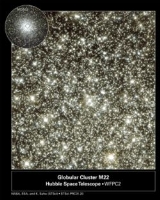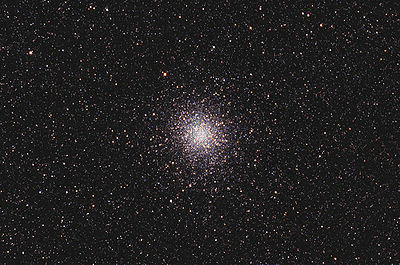
Messier 22
Encyclopedia

Globular cluster
A globular cluster is a spherical collection of stars that orbits a galactic core as a satellite. Globular clusters are very tightly bound by gravity, which gives them their spherical shapes and relatively high stellar densities toward their centers. The name of this category of star cluster is...
in the constellation
Constellation
In modern astronomy, a constellation is an internationally defined area of the celestial sphere. These areas are grouped around asterisms, patterns formed by prominent stars within apparent proximity to one another on Earth's night sky....
Sagittarius
Sagittarius (constellation)
Sagittarius is a constellation of the zodiac, the one containing the galactic center. Its name is Latin for the archer, and its symbol is , a stylized arrow. Sagittarius is commonly represented as a centaur drawing a bow...
, near the Galactic bulge region. It is one of the brightest globulars that is visible in the night sky.
History
M22 was one of the first globulars to be discovered in 1665 by Abraham Ihle and it was included in Charles Messier'sCharles Messier
Charles Messier was a French astronomer most notable for publishing an astronomical catalogue consisting of deep sky objects such as nebulae and star clusters that came to be known as the 110 "Messier objects"...
catalog of comet
Comet
A comet is an icy small Solar System body that, when close enough to the Sun, displays a visible coma and sometimes also a tail. These phenomena are both due to the effects of solar radiation and the solar wind upon the nucleus of the comet...
-like objects on June 5, 1764.
It was one of the first globular clusters to be carefully studied first by Harlow Shapley
Harlow Shapley
Harlow Shapley was an American astronomer.-Career:He was born on a farm in Nashville, Missouri, and dropped out of school with only the equivalent of a fifth-grade education...
in 1930. He discovered roughly 70,000 stars and found it had a dense core. Then Halton Arp
Halton Arp
Halton Christian Arp is an American astronomer. He is known for his 1966 Atlas of Peculiar Galaxies, which catalogues many examples of interacting and merging galaxies...
and William G. Melbourne continued studies in 1959. Because of the large color spread of its red giant branch (RGB) sequence, which is similar to that observed in Omega Centauri
Omega Centauri
Omega Centauri or NGC 5139 is a globular clusterin the constellation of Centaurus, discovered by Edmond Halley in 1677 who listed it as a nebula. Omega Centauri had been listed in Ptolemy's catalog 2000 years ago as a star. Lacaille included it in his catalog as number I.5...
, it became the object of intense scrutiny starting in 1977 with James E. Hesser et al.
Characteristics
M22 is one of the nearer globular clusters to EarthEarth
Earth is the third planet from the Sun, and the densest and fifth-largest of the eight planets in the Solar System. It is also the largest of the Solar System's four terrestrial planets...
at a distance of about 10,600 light-year
Light-year
A light-year, also light year or lightyear is a unit of length, equal to just under 10 trillion kilometres...
s away. It spans 32' on the sky which translates to a spatial diameter of 99 ± 9 light-years. 32 variable star
Variable star
A star is classified as variable if its apparent magnitude as seen from Earth changes over time, whether the changes are due to variations in the star's actual luminosity, or to variations in the amount of the star's light that is blocked from reaching Earth...
s have been recorded in M22. It is projected in front of the galactic bulge and is therefore useful for its microlensing effect on the background stars in the bulge.
Despite its relative proximity to us, this metal-poor cluster's light is limited by dust extinction, giving it an apparent magnitude of 5.5 making it the brightest globular cluster visible from mid-northern latitudes (e.g. Europe and most of North America). However, due to its southerly declination, M22 never rises high in the sky and so appears less impressive than other summer sky globulars such as M13 and M5.
Planetary Nebula
M22 is very unusual in that it is one of only four globulars (the others being M15Messier 15
Messier 15 or M15 is a globular cluster in the constellation Pegasus. It was discovered by Jean-Dominique Maraldi in 1746 and included in Charles Messier's catalogue of comet-like objects in 1764...
, NGC 6441 and Palomar 6
Palomar 6
Palomar 6 is a loose globular cluster in the constellation Ophiuchus that belongs to the halo of the Milky Way galaxy. First discovered on the Palomar Survey Sky plates by Robert G. Harrington and Fritz Zwicky,...
) that are known to contain a planetary nebula
Planetary nebula
A planetary nebula is an emission nebula consisting of an expanding glowing shell of ionized gas ejected during the asymptotic giant branch phase of certain types of stars late in their life...
. It was discovered using the IRAS
IRAS
The Infrared Astronomical Satellite was the first-ever space-based observatory to perform a survey of the entire sky at infrared wavelengths....
satellite by Fred Gillett et al.,in 1986 as a pointlike source (IRAS 18333-2357) and subsequently identified as a planetary nebula in 1989 by Gillett et al. The planetary nebula's central star is a blue star
Stellar classification
In astronomy, stellar classification is a classification of stars based on their spectral characteristics. The spectral class of a star is a designated class of a star describing the ionization of its chromosphere, what atomic excitations are most prominent in the light, giving an objective measure...
. The planetary nebula (designated GJJC1) is estimated to be a mere ~6,000 years old.
See also
- New General CatalogueNew General CatalogueThe New General Catalogue of Nebulae and Clusters of Stars is a well-known catalogue of deep sky objects in astronomy. It contains 7,840 objects, known as the NGC objects...
- Messier objectMessier objectThe Messier objects are a set of astronomical objects first listed by French astronomer Charles Messier in 1771. The original motivation of the catalogue was that Messier was a comet hunter, and was frustrated by objects which resembled but were not comets...
- List of Messier objects
- List of globular clusters

